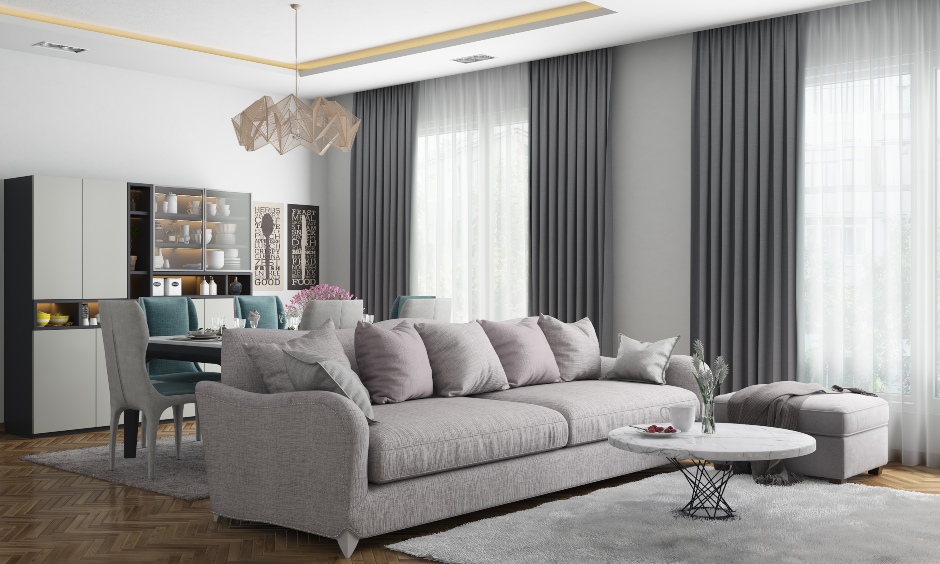A key element of any living room, curtains have the ability to set the tone for the space. From light and breezy to elegant and opulent, the options are endless.
Choosing curtains can be difficult, but it doesn’t have to be. With a few simple tips, you can find the perfect curtains for your home.
1. Consider Your Window Size
When shopping for curtains, it’s important to know the dimensions of your window, including the width and height. This will help you narrow down the many different options to find the perfect curtain set for your living room. The height of your curtains will determine how far they reach out from the window frame, as well as how wide they hang.
The length of your curtains is also important. Do you want them to puddle on the floor, or do you prefer for them to fall just above the window sill? Taking into account your personal taste and the style of your room will help you decide on the perfect length.
Another thing to consider is whether you’d like your curtains to match the color of your wall paint or go against it. Lighter colors are more neutral and will blend in with your walls, while dark shades can create a more dramatic look that’s perfect for some living rooms. When choosing the right color for your curtains, it’s also a good idea to keep in mind the other colors and patterns that are already present in your room, as well as any accent pieces such as large area rugs or throw pillows.
You should also consider the function of your curtains — do you want them to provide privacy, filter light, add insulation, or just add a stylish touch? Answering these questions will help you select the best fabric for your curtains. For example, if you want your curtains to block out all sunlight from entering the room, then you may need to choose thicker fabrics or blackout curtains.
Once you’ve determined the function of your curtains, it’s time to start deciding on the fabric type and color. Cotton curtains are popular for their versatility, durability, and light filtration capabilities. They can be hung alone or with sheers to create a light and airy feel, or they can be layered with velvet or lace for a more elegant look.
Another popular option is a linen curtain, which is lightweight and durable. It can be used alone or with a lining to provide more privacy and block out light. It also drapes beautifully, making it a great choice for those who want a more tailored look.
2. Pick the Right Fabric
If you want your curtains to be more than simple window coverings, a proper fabric choice is key. Depending on your room’s décor and your personal style, there are many different curtain fabrics to choose from. The right fabric will elevate and accentuate other design elements, such as your living room furniture. It will also help your curtains provide their intended function – such as privacy, light control or insulation.
Choosing a curtain material that is appropriate for your room is just as important as picking the right size and length. The fabric should be thick enough to block out sunlight, while still allowing light to filter through and offering a bit of insulation. In addition, the fabric should be soft and durable enough to provide a comfortable drape.
Polyester is a popular choice, as it’s inexpensive and durable. It’s also easy to clean, and it doesn’t wrinkle or stretch. However, if you’re interested in a more luxurious look, velvet is an excellent option. It’s extremely soft and opulent, and it’s also hypoallergenic and resistant to mildew.
Other popular curtain materials include cotton and linen. Both are breathable, soft and durable, and come in a variety of colors and styles. Linen is especially stylish and versatile, as it looks great with both modern and traditional decor. Another good choice is canvas, which is a heavyweight fabric that’s great for blocking out light and providing insulation.
Lastly, you should consider the color of your walls and other design elements in your living room when choosing the best curtain fabric. It’s crucial to select curtains that coordinate seamlessly with your space, so you don’t end up with a clash of colors and textures. If your home adheres to an overarching color story or motif, it’s a good idea to consult a color wheel for guidance on selecting complementary colors that will accentuate rather than overpower one another.
You can also use a color wheel to determine the best fabric for your living room curtains based on their hue. If you have brown-painted walls, for example, you can choose curtains in bright pinks and cool shades of grey to complement them.
3. Pick the Right Color
Curtains not only add to the visual appeal of a living room, they also protect the space from sunlight and enhance the ambience. This is especially important in warmer climates, where harsh sun rays can be harmful to your furniture and flooring. Curtains come in a variety of lengths and fabrics to suit different design aesthetics. Generally, curtains should extend to the floor for the most stylish effect, but if your room layout or furniture placement makes this impractical, opting for shades may be more practical and still add to the decor.
Besides window size, curtain color is another major consideration. Depending on whether you want your curtains to blend in or make a statement, choose either matching or complementary colors based on the dominant hues of your room. For example, if you have a lot of blue in your living room, opting for neutral or greenish shades will complement the decor and help create a balanced and harmonious look. On the other hand, if you have a lot of red in your living room, going for yellow or orange shades can give it an exciting and vibrant look.
If you choose a color that matches your wall color, opt for a lighter shade for more airy and breezy curtains. However, if you want to add a little contrast and personality to the space, choose a darker shade or patterned curtains. Just make sure that the patterns and colors do not clash with other home decor pieces, especially any upholstered chairs or sofas in the room.
You also need to consider the type of curtain rod you will use for the curtains. There are many options available, from simple poles to elaborate decorative finials. Ensure that the rod material matches your living room’s overall decor and that it can support the weight of the chosen fabric. Also, the rod should be compatible with your desired curtain style and function – for example, a French return rod that returns to the wall at each end is ideal for elegant and streamlined curtains.
4. Choose Wisely Between Prints and Solids
A crucial finishing touch, curtains can dramatically alter the atmosphere of a room. They add color, create privacy, and allow you to carry a theme or palette throughout your entire living space. While there are many options available, narrowing down the best fabric types and colors can help you find the perfect pair of curtains for your home.
Considering the proportions of your windows, ceiling height, and intended curtain functionality alongside accurate length and width measurements will ensure that your new curtains will perfectly suit your space. The type of rod you choose also plays a role in the overall look and feel of your space, so keep in mind that there are a wide variety of materials and styles to consider. For example, metal hardware may offer a more modern aesthetic, while wooden rods can provide a classic finish.
In addition to choosing the right type of rod, you will need to decide on the style of your curtains as well. Puddling, or trousers-length, are curtains that hang about an inch longer than floor length for a fuller appearance. These curtains can be dressed up or down with the use of trims and accessories.
For a more polished look, try matching your curtains to the color of your furniture. This will give your living room a sleek and sophisticated feel. For a more relaxed vibe, you can mix and match different fabrics and textures to create an eclectic and unique look.
If you want your curtains to be more of a focal point, opt for a patterned fabric. However, if you’re looking for something more understated and elegant, a solid fabric might be the way to go.
Once you’ve decided on the material, color, and length of your curtains, it’s time to start thinking about how you’ll hang them. Consider whether you want to hang your curtains straight or gathered, and think about how they will sit in relation to your furniture. For instance, if you have a tufted sofa, your curtains might be better suited for a softer look when they’re hung in a more formal manner.

